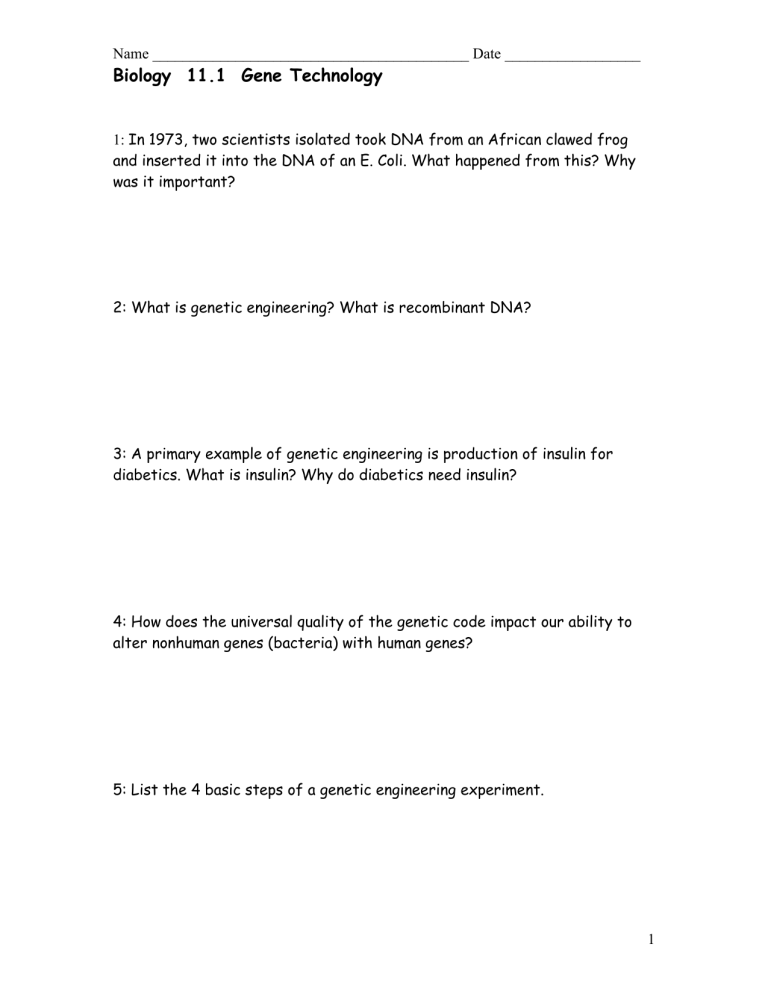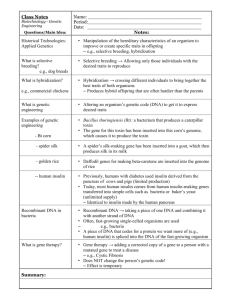1: In 1973, two scientists isolated took DNA from an African clawed

Name __________________________________________ Date __________________
Biology 11.1 Gene Technology
1:
In 1973, two scientists isolated took DNA from an African clawed frog and inserted it into the DNA of an E. Coli. What happened from this? Why was it important?
2: What is genetic engineering? What is recombinant DNA?
3: A primary example of genetic engineering is production of insulin for diabetics. What is insulin? Why do diabetics need insulin?
4: How does the universal quality of the genetic code impact our ability to alter nonhuman genes (bacteria) with human genes?
5: List the 4 basic steps of a genetic engineering experiment.
1
Name __________________________________________ Date __________________
Biology 11.1 Gene Technology
6: In step 1; when the DNA is cut from the organisms genes, restrictive enzymes do the cutting. What are restrictive enzymes?
7: What is a vector? Name three commonly used vectors.
8: What is a plasmid?
9: What enzyme is used to bind the DNA that is cut and placed into the vector? What do we call the plasmid once the new DNA is spliced into it?
10: Many copies of this new recombinant DNA plasmid hybrid will be made each time the cell reproduces by fission. What process allows this?
11: In the screening step what do we separate from what?
2
Name __________________________________________ Date __________________
Biology 11.1 Gene Technology
12: What do we mean when we say a gene section is a palindrome?
13: What are “sticky ends”?
14: When two sections with sticky ends bond together, what allows the two
DNA molecules to do this?
15: In selecting and screening cells; what is the first step?
16: When some of the cells have taken up a vector that makes them resistant to tetracycline; and than you expose all the cells to tetracycline, what happens to the cells that did NOT take up the vector?
17: After some of the cells die off; what happens to the remaining cells that did take up the vector?
3
Name __________________________________________ Date __________________
Biology 11.1 Gene Technology
18: What is one method for identifying a “gene of interest” in a surviving bacterial colony?
19: What process separates the DNA fragments (Step 2) after the restrictive enzymes have cut them into pieces?
20: Why does the DNA migrate toward the positive pole when the power is applied?
21: As the DNA fragments move through the gel; which particles move fastest; the smallest or largest DNA?
22: How are the DNA bands transferred directly to another piece of paper?
What is the filter paper moistened with that attaches to the DNA bands?
4
Name __________________________________________ Date __________________
Biology 11.1 Gene Technology
23: What types of DNA fragments will be attracted to the bands and form visible bands on the filter sheet?
24: Once the bacterial colonies with the “gene of interest” are identified; how can this be used by researchers? Give an example.
25: What can researchers study by comparing the nucleotide sequences of several different organisms?
5







